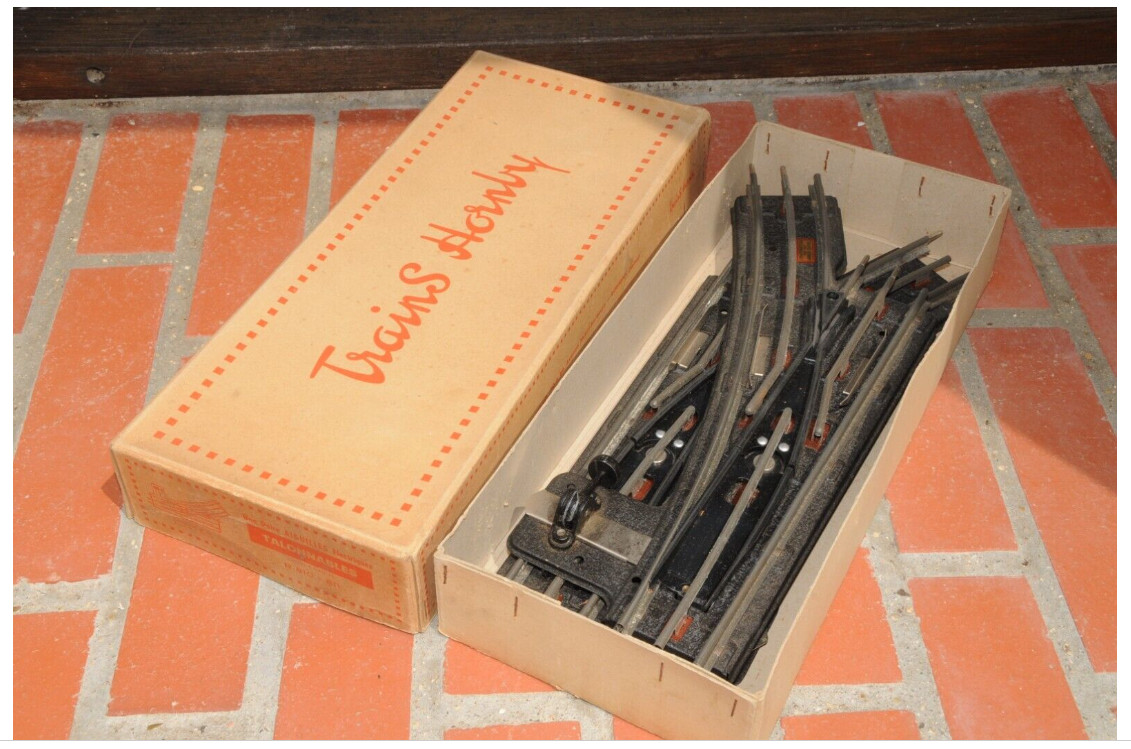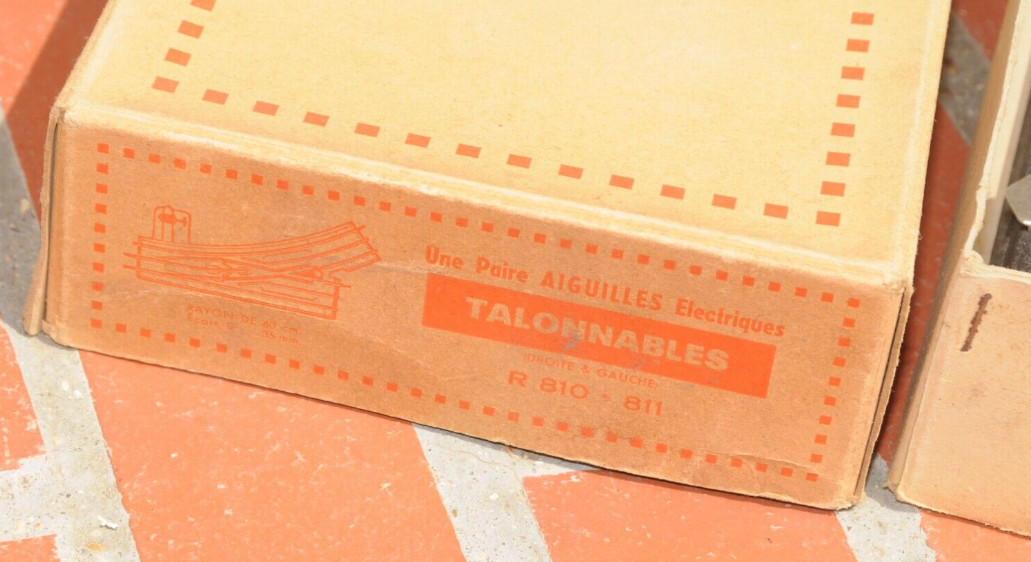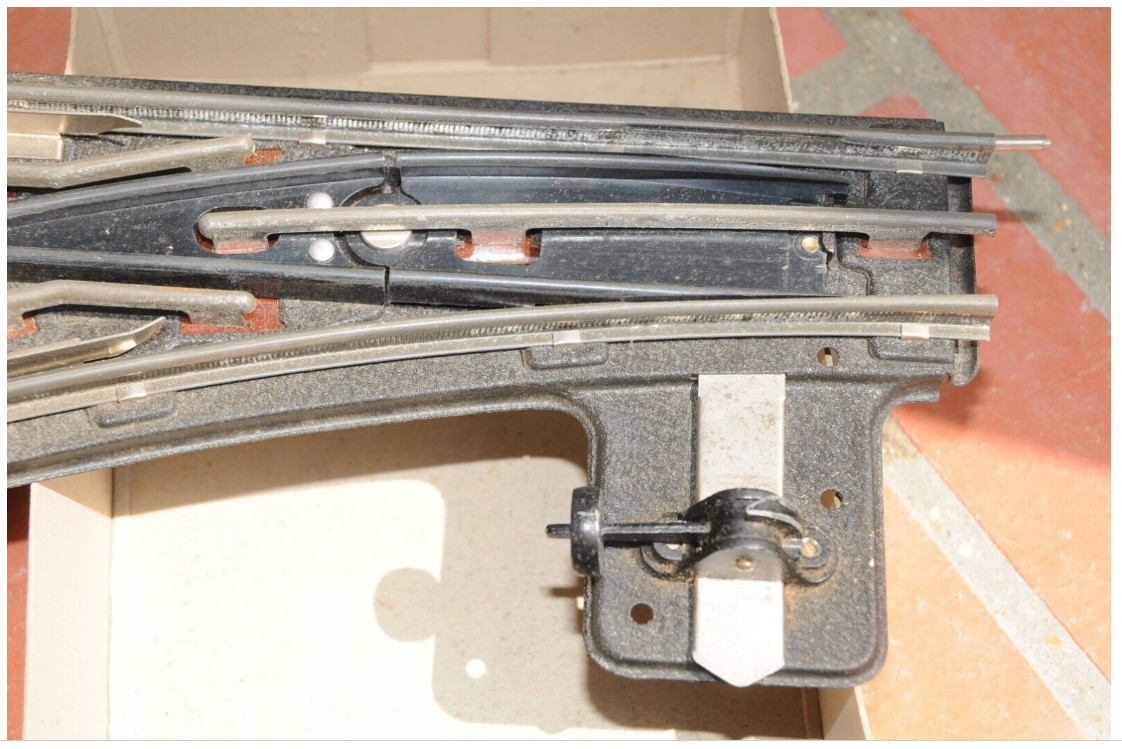oace
Full Member
  
Posts: 241
|
Post by oace on Mar 9, 2024 12:45:33 GMT
Hello Guys ! I ask for your help and knowledge about designing a Reversing Loop for a 3-rails Tinplate layout...  That is to say something like the schematic below :  Awaiting my bunch of Menards 3-rails tubular Tinplate tracks, I was wondering if there existed turnouts / switches / points (I don't know the correct term for our French term aiguillages, my apologies !) that also offer a "non-derailing" feature, where they will automatically flip to the correct position when a train approaches, but in Tinplate 3-rails version ? I mean : As a train approaches a turnout, the turnout will flip to the correct position, without any manual intervention for switching the direction. As the train moves around the loop and approaches the turnout from a different side, the turnout will flip to the correct position. I had that kind of switch 30 years ago in HO, made by Fleischmann (de). On these, the switching was mechanical (with springs), and the wheels of the locomotive itself "pushed" the points in the good direction. But does it exists for O gauge Tinplate layout ? Or is there any convenient Tinplate 3-rails track solution for that switch problem ? I hope I am clear in my description...   Thanks in advance for your input and tips !   OACE |
|
|
|
Post by josef on Mar 9, 2024 14:06:29 GMT
There are rerailer tracks available for Lionel Fast Tracj and tubular tracks. I do know that Fastrack will switch automatically when coming into a turnout not aligned or positioned correctly from a reverse loop, but not coming into one. As to tubalar track I don't remember but seems it should.
Now on fast track it won't switch back automatically. You'll be going into the inside and coming back around in a clockwise position, but will switch automatically in your drawing, to continue going into the straig part clockwise. Same coming back, going counter clockwise as per your drawing, once engine hits the switch the force of the wheels will switch it to continue going clockwise now.
|
|
|
|
Post by harborbelt70 on Mar 9, 2024 14:21:09 GMT
If I am not mistaken, practically any Lionel or MTH tubular track switch that is powered (i.e. not a completely manual switch, such as used to be made for Super-O track) has a non-derailing feature that turns the switch to the loco's direction of travel coming out of the curved section. Obviously in your case if the switch is set to turn into the curve from a straight section that's where the engine will go but in any case it will have the reverse direction of travel when returning to the straight.
|
|
|
|
Post by runamuckchuck on Mar 9, 2024 14:22:18 GMT
Ross switches may have the feature you are looking for non derailing wise. Check out Sean's Train Depot Switches, Switches, Switches video on You Tube. You may find it useful.
|
|
oace
Full Member
  
Posts: 241
|
Post by oace on Mar 9, 2024 17:23:27 GMT
Thank you josef, harborbelt70 and runamuckchuck ! Well it is somewhat difficult for me - as a non-native English language - to explain and describe exactly the situation, but it seems that you all three have understood what I was seaching for...  I see, josef. What I am searching for, is a switch whose "needles" will be oriented by the force of the wheels of the locomotive "leaving the loop", if I can say so, re-using your terms. When entering in the loop, the locomotive can enter the "straight" or "turning" section of the switch : this has no importance for me, even if it alternates on time "straight", one time "curve" sections, no matter. I mean : the "needles" of the switch can stay in the last position left by the wheels of the last the train passing by on the switch, no need to switch back automatically. So harborbelt70, If I understand clearly your purpose, I would rather need a switch which doesn't "lock" in position mechanically, like a manual switch would (via its lever), but an automatic - or motorized switch - on which the motor has been removed (no actuator), in order to allow the "needles" of the switch to orient freely in the correct direction, via the force of the wheels of the locomotive leaving (exiting) the reversing loop. If such a device in Tinplate 3-rails exists, then would you point me in the right direction for some convenient products ? (No puns intended !  ) Yes runamuckchuck ! Thanks for the tip - very useful, indeed - Sean's (magnificent gauge 1 layout) video explains exactly (after 12:20) what I described to @harborbelt a few lines above : the "needle" have to be free to orient themselves by the passage of the wheels. Sean call it "free floating center point". Yes. The ROSS switches (assuming they exist in O gauge 072) have the feature I am looking for, but possibly the other switch presented (green base MTH) could be modified to remove the locking mechanism, and add a light flip-flop spring to insure (maintain) good "needle" orientation, just like on my Fleischmann HO switches. This could be experimented on other tinplate switches, I guess... I will explore that question : ROSS offers and DIY modifications ! OACE |
|
|
|
Post by harborbelt70 on Mar 9, 2024 22:25:06 GMT
I had a moment's doubt about your reference to "tinplate" trains in case you were taking about a different gauge to 3rail O but if you are using Fastrack these must be trains that run on standard O track. In any case I found a good short explanation of the non-derailing feature in a post I saw a long time ago, and specifically this addresses the difference between manual and remote control switches:
"The remote [control] switches throw the switch point rather than having the wheels [and the weight of the engine] push them. There are insulated rails and the wheels complete the circuit to throw the switch."
The context was that a few years back there was a problem with certain left-hand Fastrack switches such as the one shown in your track diagram. It was that these switches had been wired incorrectly at the factory (welcome to 3rail O scale from Lionel) but the fix was relatively easy as described here:
mrmuffinstrains.com/blogs/good-to-know/lionel-lh-switches-anti-derailing-fix
This was 5+ years ago but some of that stock might still be around and being sold. I don't know enough about Ross track to help you with that but if you buy a switch from them make sure that it is non-derailing and that if you want to mate it to any Fastrack you have whatever adapters are required.
|
|
|
|
Post by firewood on Mar 9, 2024 23:54:44 GMT
I have older K-Line switches on my layout - the powered ones are all non-derailing. I have no experience with Lionel switches.
A friend has Fastrack un-powered switches. They self-correct as the train passes through, but any locomotives with lightweight leading trucks sometimes derail on them.
I hope all our information helps.
|
|
oace
Full Member
  
Posts: 241
|
Post by oace on Mar 10, 2024 8:16:09 GMT
Thanks @harborbelt and firewood for your tips and advices ! Yes, I understand that when pushing the "free floating center point", a wheel-derailment could arise for mechanical reasons of "uncomplete switching of the needles" or "poor wheel switching force" (from the front truck of some 2-6-4 for example), so that's why you recommend a triggered switching via a motor and a contact operating the switch when the locomotive approaches ; a system which would be safer, indeed. The problem is that a triggered solution needs to be supplied : wires of great lenght, etc... Which is complicated and unpractical for a temporary layout, variable in size, shape and location ! So you understand why I would prefer a pure mechanical solution, simply driven by the force of the wheels. So, at your suggestion, I contacted ROSS Custom Switches about my need : I wait for an answer from them. OACE |
|
|
|
Post by harborbelt70 on Mar 10, 2024 15:14:26 GMT
Last word from me - bear in mind that (1) Lionel Fastrack remote control switches (and earlier Lionel or MTH traditional tubular track switches) can be powered from the track rather than wiring to an accessory power source - in fact track power is the default setting so that you ordinarily don't need long wires back to the transformer power source, and (b) these switches are not the same design as smaller scale ones so be careful about generalizing from DC turnouts to traditional 3rail O scale, which may actually only complicate matters.
|
|
|
|
Post by rtraincollector on Mar 10, 2024 15:53:16 GMT
Most Lionel switches have the automatic alignment once the engine hits the switch, no mater which side it comes to. Only some real old switches don't.
La plupart des interrupteurs Lionel ont l'alignement automatique une fois que le moteur frappe l'interrupteur, peu importe de quel côté il se trouve. Seuls certains vrais vieux interrupteurs ne le font pas.
|
|
|
|
Post by harborbelt70 on Mar 10, 2024 17:37:52 GMT
Most Lionel switches have the automatic alignment once the engine hits the switch, no mater which side it comes to. Only some real old switches don't.
La plupart des interrupteurs Lionel ont l'alignement automatique une fois que le moteur frappe l'interrupteur, peu importe de quel côté il se trouve. Seuls certains vrais vieux interrupteurs ne le font pas.
|
|
|
|
Post by rtraincollector on Mar 10, 2024 18:13:35 GMT
Thank-you. easily done just find a English to French translation on the computer. Just thought it might be nice to reply in his native tongue.
|
|
|
|
Post by steveoncattailcreek on Mar 10, 2024 20:39:02 GMT
Thank-you. easily done just find a English to French translation on the computer. Just thought it might be nice to reply in his native tongue. What -- the AIs have *tongues* now?? 
|
|
oace
Full Member
  
Posts: 241
|
Post by oace on Mar 10, 2024 21:38:35 GMT
rtraincollector : yes, fine ! I'm glad to see that I'm not alone to front problems sometimes in finding the correct matching term in another language...   Switch - if I am correct - is also called "points" at least in UK, and possibly in USA ? To name the moving sections of rails of a switch, I used the term "needles", but it seems that "blades" is more appropriate ?  In French : - for the "switches", we say aiguillages. - for the "needles" or "blades" we say aiguilles. (direct translation = "needles") - for switches that can be "switched by the force of the wheels passage", we say aiguillages talonnables. (direct translation = "heelable switches"... Any sense ? Dubious !  ) - interrupteur is the name given to that common electrical device which cuts or establishes the current, that you also call "switch" ! - a "selector" would be called commutateur or sélecteur. ( sélecteur d'entrée = "input selector") That said, thank you so much Guys to make the effort to be clear in writing your explanations, so I can understand them readily ! I really appreciate...  OACE
|
|
oace
Full Member
  
Posts: 241
|
Post by oace on Mar 10, 2024 22:10:37 GMT
While writing this, I discovered that Hornby offered "heelable switches" =aiguillages talonnables , under the reference R810 and R811, and I could find two pairs in fair condition - as a preliminary test, and for less of the price of a brand new ROSS switch - before investing in those costy devices (think transit and customs to France) :    I'll see if they work as expected for my reversing loop... OACE |
|